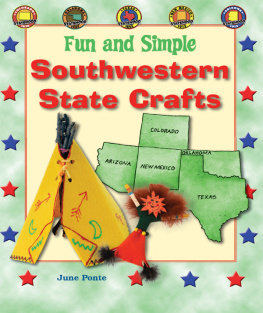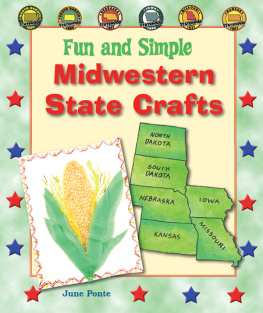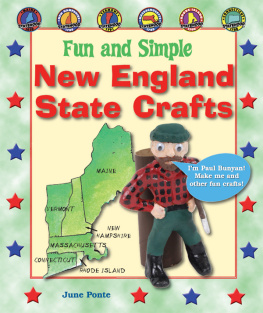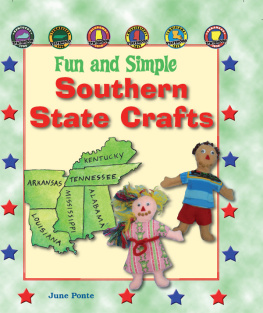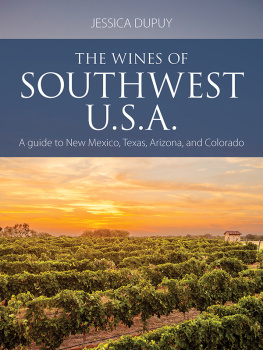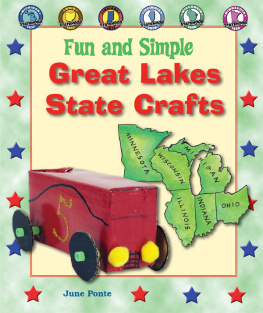DO YOU KNOW YOUR STATES?
Learn interesting and exciting facts about Southwestern states while creating fun crafts!
Find out about each state's capital, motto, f lower, animal, and more! Make a Mini Tepee, Longhorn Steer Book Cover, Kachina Doll Magnet, or one of the other crafts in this book.
"The crafts are simple and educational. They will be enjoyed by school age children."
Dr. Salome C. Nnoromele, Director, African/African-American Studies, Eastern Kentucky University
"One of the fastest growing regions of the United States, what is known as "the sunbelt," is explored in this book. Learn some interesting history and geography about this fast growing region of the United States at the same time you complete fun craft projects representative of the southwestern United States."
Duncan R. Jamieson, Ph.D., Professor of History, Ashland University
About the Author
June Ponte, illustrator and fine artist, grew up surrounded by her mother's artwork. She was inspired by tales of her eccentric grandfather, who used a fountain pen to draw majestic schooners on her grandmother's linen tablecloths. This is her first series with Enslow Publishers, Inc.

Colorado, Oklahoma, Texas, New Mexico, and Arizona are the five states in the Southwest. This area is referred to as the Southwest because the states are located in the southwestern region of the United States.
The Southwest has an interesting past, dating back to the American Indians that first lived in the area. Later, Spanish explorers, settlers from the eastern part of the country, and cowboys all added to the colorful history of the region.

The geography of the southwestern states is varied. It includes the Grand Canyon, the Colorado River and the Rio Grande, mountains, and deserts. Texas, New Mexico, and Arizona share a border with the United States neighbor to the south, Mexico. More than fifty Colorado Rocky Mountains are higher than fourteen thousand feet above sea level. These are the tallest mountains in the entire chain of Rocky Mountains, which extends from Mexico to Alaska. The Gypsum Hills in Oklahoma are sometimes called the Glass Hills because of the sparkly mineral gypsum that is found in the hills. Arizonas colorful red, orange, gray, and yellow Painted Desert is a badlands area. Badlands are places that have strange rock formations, unusually shaped hills, and very little plant life. Much of the Painted Desert is the homeland of the Navajo Indians.


Image Credit: 1999 Artville, LLC.

| Origin of name | The name Colorado comes from the Spanish word meaning colored red. |
Flag
 Image Credit: 2001 Robesus, Inc. | Colorados state flag has three wide stripes; two are blue, and one is white. The white stripe stands for the states snow-capped mountains. The blue stripe stands for the blue Colorado sky. The red stands for the reddish Colorado soil. In the center of the flag is a large red letter C. Inside the letter C is a gold circle that represents the sunshine in Colorado. |
| Capital | Denver |
| Nickname | The Centennial State |
| Motto | Nil sine Numine (This is a Latin phrase which means nothing without the deity.) |
| Size (in area) | 8th largest |
| Animal | Rocky Mountain bighorn sheep |
| Bird | lark bunting |
| Flower | white and lavender columbine
 Image Credit: 2007 Jupiterimages, all clipart |
| Fossil | stegosaurus
 Image Credit: 2007 Jupiterimages, all clipart |
| Tree | Colorado blue spruce |
| Industry | ranching, agriculture, technology, oil, natural gas, tourism |
- six small twigs
- yarn
- pencil
- poster board
- stiff felt
- fabric puff paint
- scissors
- white glue
In Mancos, Colorado, there is a piece of folk art called The Rain of Arrows. Seven 30-foot-tall arrows are near three 25-foot-tall tepees. Wilma Brimhall, a Navajo, created this folk art in 1959 with the help of other local Navajo.

1. Tie the ends of the six twigs together tightly with yarn.
2. Draw a triangle on the poster board. (See for the pattern.) Cut it out.

3. Trace the poster board triangle onto felt five times with a permanent marker. All top points of the triangles should be touching. Cut along the outside edge only of the five triangles. Draw over the inside triangle lines with the point of a pencil so the stiff felt will bend along these lines.
4. Use fabric puff paint to make designs on the tepee. Let dry.
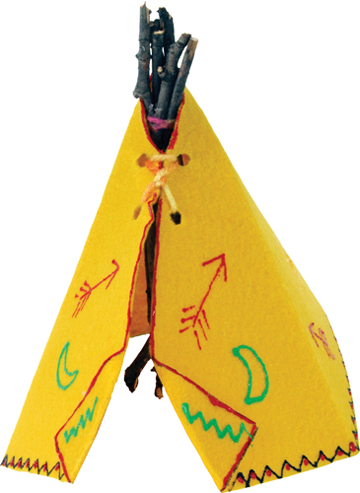
5. Bend the felt into a tepee shape. Cut two 1/4-inch-wide holes, 1 inch apart, on both edges of the tepee. The holes should be made 1 inch from the top of the tepee. Thread yarn through the holes. Fold the two bottom corners of the tepee back to create a door. Glue the corners to the tepee to keep the door open. Let dry. Place the twigs through the top of the tepee.
- pencils
- poster board
- colored markers
- metallic markers
- white glue
- (Ask permission first!) household items such as:
- bottle caps
- cotton balls
- cotton swabs
- fabric scraps
- paper clips
- toothpicks
Architects are artists who draw buildings and decide how those buildings will look. Charles Deaton, an architect, built a house for himself near Denver, Colorado, that is known as the Sculptured House. It is on a hill, and it looks like a house from the future, even though the architect built his house in the 1960s. Some people think it looks like a flying saucer. What would your dream house look like?
1. Draw your own dream house using a pencil on poster board. Add such details as windows, chimneys, doors, fences, trees, a yardwhatever you wish. When you are finished, go over the pencil lines with a marker.

